A Comparative Analysis of Climate Change Impacts and Future in India
VerifiedAdded on 2020/05/28
|6
|854
|77
Report
AI Summary
This report provides an analysis of climate change in India, focusing on its potential future impacts if current trends continue. It highlights the projected increase in average temperatures, prolonged heat-wave conditions, and the environmental consequences such as water crises, increased droughts, and challenges to food security. The report compares India's situation with that of other countries, such as those in South America, emphasizing the impact on agriculture and the working population. The report also examines the impact of rising sea surface temperatures, leading to heavy monsoon rainfall, and the potential for increased climate-related health issues. The report concludes by emphasizing the vulnerability of India to climate change and the need for proactive measures to mitigate its effects.
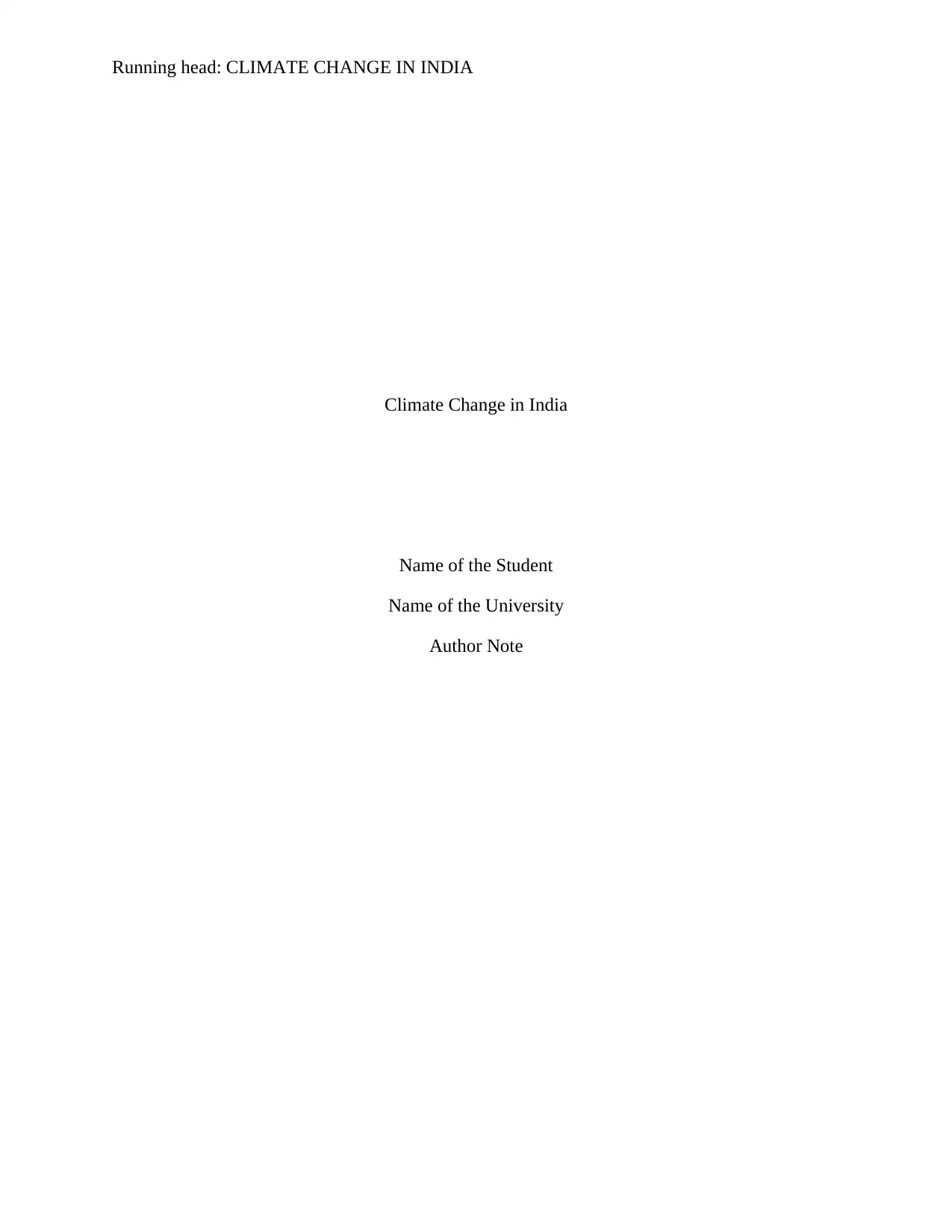
Running head: CLIMATE CHANGE IN INDIA
Climate Change in India
Name of the Student
Name of the University
Author Note
Climate Change in India
Name of the Student
Name of the University
Author Note
Paraphrase This Document
Need a fresh take? Get an instant paraphrase of this document with our AI Paraphraser
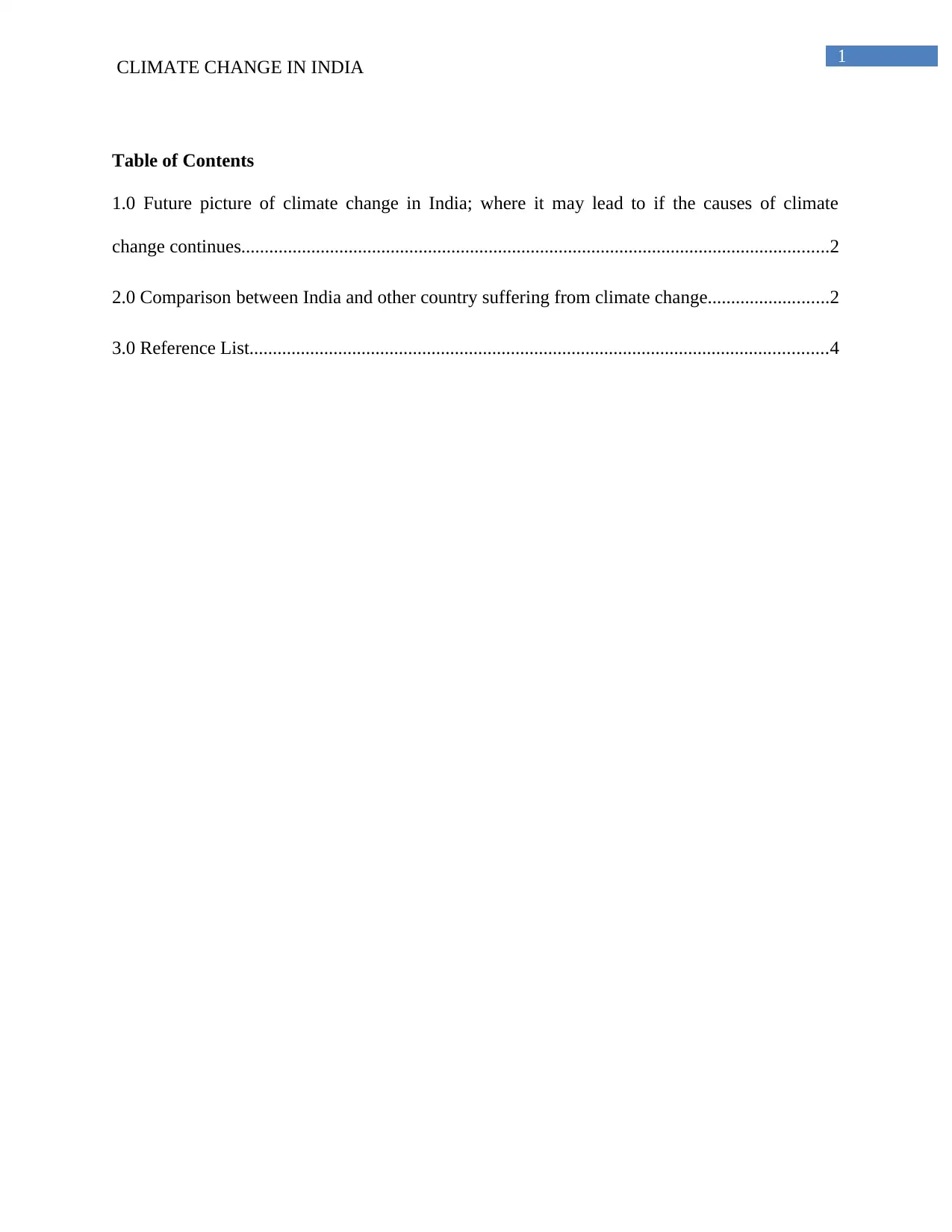
1
CLIMATE CHANGE IN INDIA
Table of Contents
1.0 Future picture of climate change in India; where it may lead to if the causes of climate
change continues..............................................................................................................................2
2.0 Comparison between India and other country suffering from climate change..........................2
3.0 Reference List............................................................................................................................4
CLIMATE CHANGE IN INDIA
Table of Contents
1.0 Future picture of climate change in India; where it may lead to if the causes of climate
change continues..............................................................................................................................2
2.0 Comparison between India and other country suffering from climate change..........................2
3.0 Reference List............................................................................................................................4
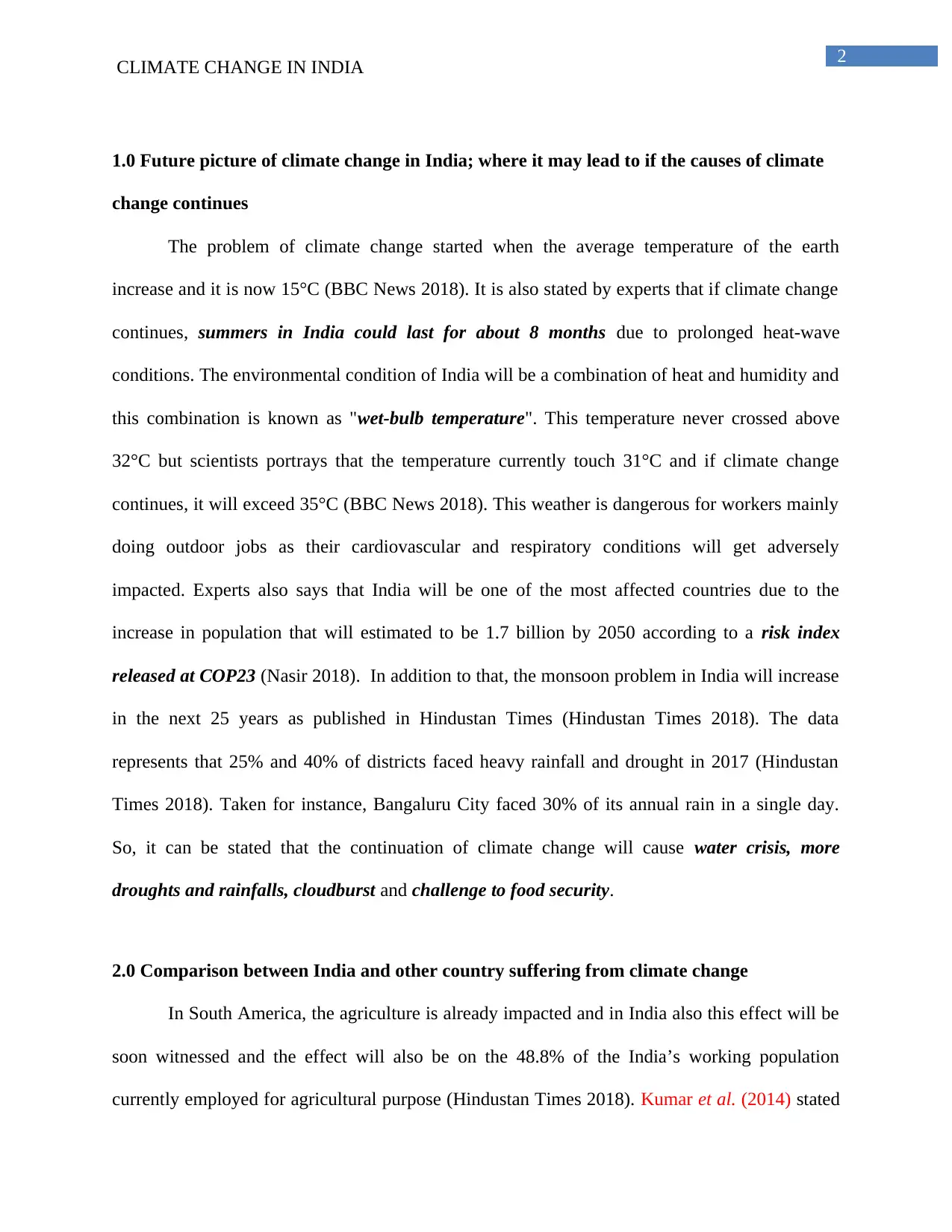
2
CLIMATE CHANGE IN INDIA
1.0 Future picture of climate change in India; where it may lead to if the causes of climate
change continues
The problem of climate change started when the average temperature of the earth
increase and it is now 15°C (BBC News 2018). It is also stated by experts that if climate change
continues, summers in India could last for about 8 months due to prolonged heat-wave
conditions. The environmental condition of India will be a combination of heat and humidity and
this combination is known as "wet-bulb temperature". This temperature never crossed above
32°C but scientists portrays that the temperature currently touch 31°C and if climate change
continues, it will exceed 35°C (BBC News 2018). This weather is dangerous for workers mainly
doing outdoor jobs as their cardiovascular and respiratory conditions will get adversely
impacted. Experts also says that India will be one of the most affected countries due to the
increase in population that will estimated to be 1.7 billion by 2050 according to a risk index
released at COP23 (Nasir 2018). In addition to that, the monsoon problem in India will increase
in the next 25 years as published in Hindustan Times (Hindustan Times 2018). The data
represents that 25% and 40% of districts faced heavy rainfall and drought in 2017 (Hindustan
Times 2018). Taken for instance, Bangaluru City faced 30% of its annual rain in a single day.
So, it can be stated that the continuation of climate change will cause water crisis, more
droughts and rainfalls, cloudburst and challenge to food security.
2.0 Comparison between India and other country suffering from climate change
In South America, the agriculture is already impacted and in India also this effect will be
soon witnessed and the effect will also be on the 48.8% of the India’s working population
currently employed for agricultural purpose (Hindustan Times 2018). Kumar et al. (2014) stated
CLIMATE CHANGE IN INDIA
1.0 Future picture of climate change in India; where it may lead to if the causes of climate
change continues
The problem of climate change started when the average temperature of the earth
increase and it is now 15°C (BBC News 2018). It is also stated by experts that if climate change
continues, summers in India could last for about 8 months due to prolonged heat-wave
conditions. The environmental condition of India will be a combination of heat and humidity and
this combination is known as "wet-bulb temperature". This temperature never crossed above
32°C but scientists portrays that the temperature currently touch 31°C and if climate change
continues, it will exceed 35°C (BBC News 2018). This weather is dangerous for workers mainly
doing outdoor jobs as their cardiovascular and respiratory conditions will get adversely
impacted. Experts also says that India will be one of the most affected countries due to the
increase in population that will estimated to be 1.7 billion by 2050 according to a risk index
released at COP23 (Nasir 2018). In addition to that, the monsoon problem in India will increase
in the next 25 years as published in Hindustan Times (Hindustan Times 2018). The data
represents that 25% and 40% of districts faced heavy rainfall and drought in 2017 (Hindustan
Times 2018). Taken for instance, Bangaluru City faced 30% of its annual rain in a single day.
So, it can be stated that the continuation of climate change will cause water crisis, more
droughts and rainfalls, cloudburst and challenge to food security.
2.0 Comparison between India and other country suffering from climate change
In South America, the agriculture is already impacted and in India also this effect will be
soon witnessed and the effect will also be on the 48.8% of the India’s working population
currently employed for agricultural purpose (Hindustan Times 2018). Kumar et al. (2014) stated
⊘ This is a preview!⊘
Do you want full access?
Subscribe today to unlock all pages.

Trusted by 1+ million students worldwide
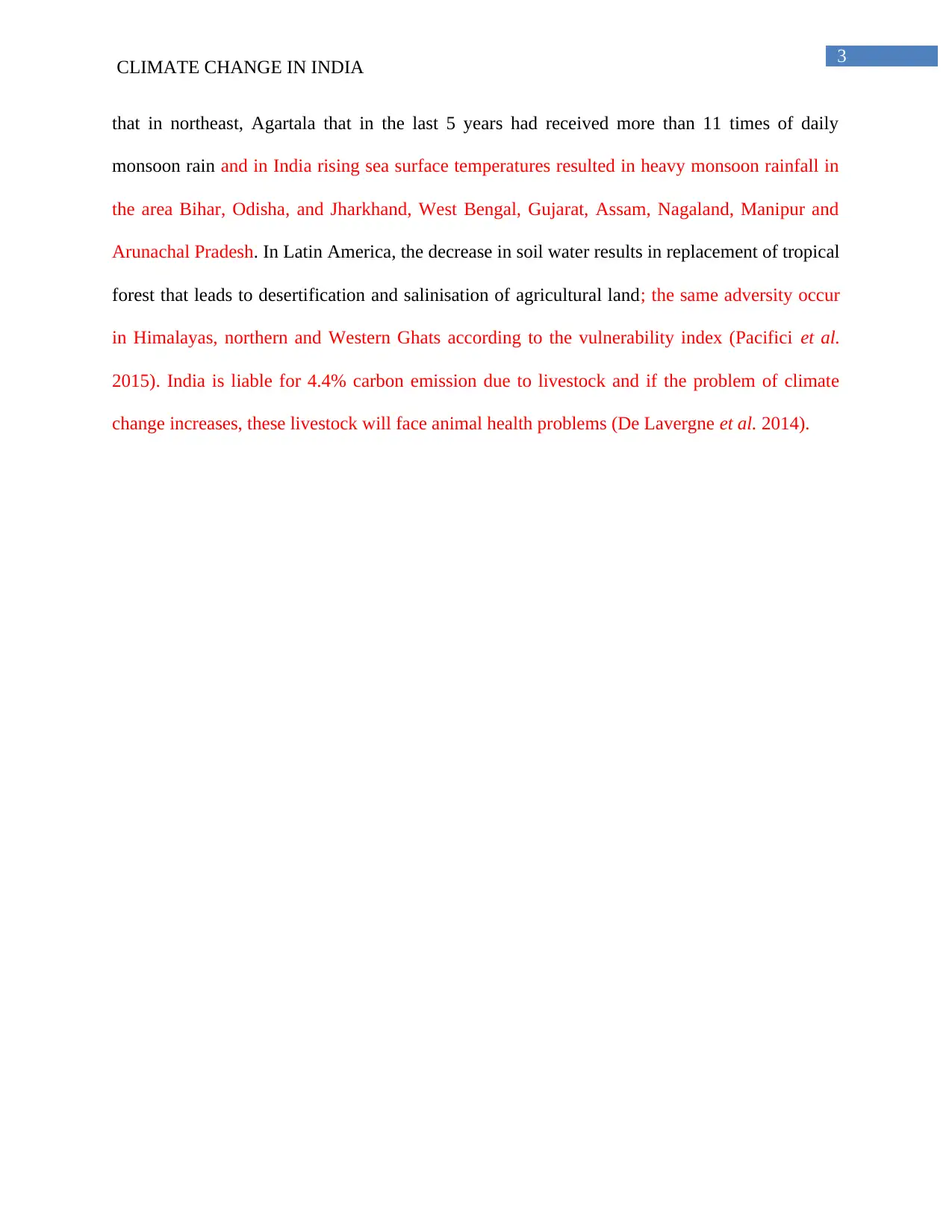
3
CLIMATE CHANGE IN INDIA
that in northeast, Agartala that in the last 5 years had received more than 11 times of daily
monsoon rain and in India rising sea surface temperatures resulted in heavy monsoon rainfall in
the area Bihar, Odisha, and Jharkhand, West Bengal, Gujarat, Assam, Nagaland, Manipur and
Arunachal Pradesh. In Latin America, the decrease in soil water results in replacement of tropical
forest that leads to desertification and salinisation of agricultural land; the same adversity occur
in Himalayas, northern and Western Ghats according to the vulnerability index (Pacifici et al.
2015). India is liable for 4.4% carbon emission due to livestock and if the problem of climate
change increases, these livestock will face animal health problems (De Lavergne et al. 2014).
CLIMATE CHANGE IN INDIA
that in northeast, Agartala that in the last 5 years had received more than 11 times of daily
monsoon rain and in India rising sea surface temperatures resulted in heavy monsoon rainfall in
the area Bihar, Odisha, and Jharkhand, West Bengal, Gujarat, Assam, Nagaland, Manipur and
Arunachal Pradesh. In Latin America, the decrease in soil water results in replacement of tropical
forest that leads to desertification and salinisation of agricultural land; the same adversity occur
in Himalayas, northern and Western Ghats according to the vulnerability index (Pacifici et al.
2015). India is liable for 4.4% carbon emission due to livestock and if the problem of climate
change increases, these livestock will face animal health problems (De Lavergne et al. 2014).
Paraphrase This Document
Need a fresh take? Get an instant paraphrase of this document with our AI Paraphraser
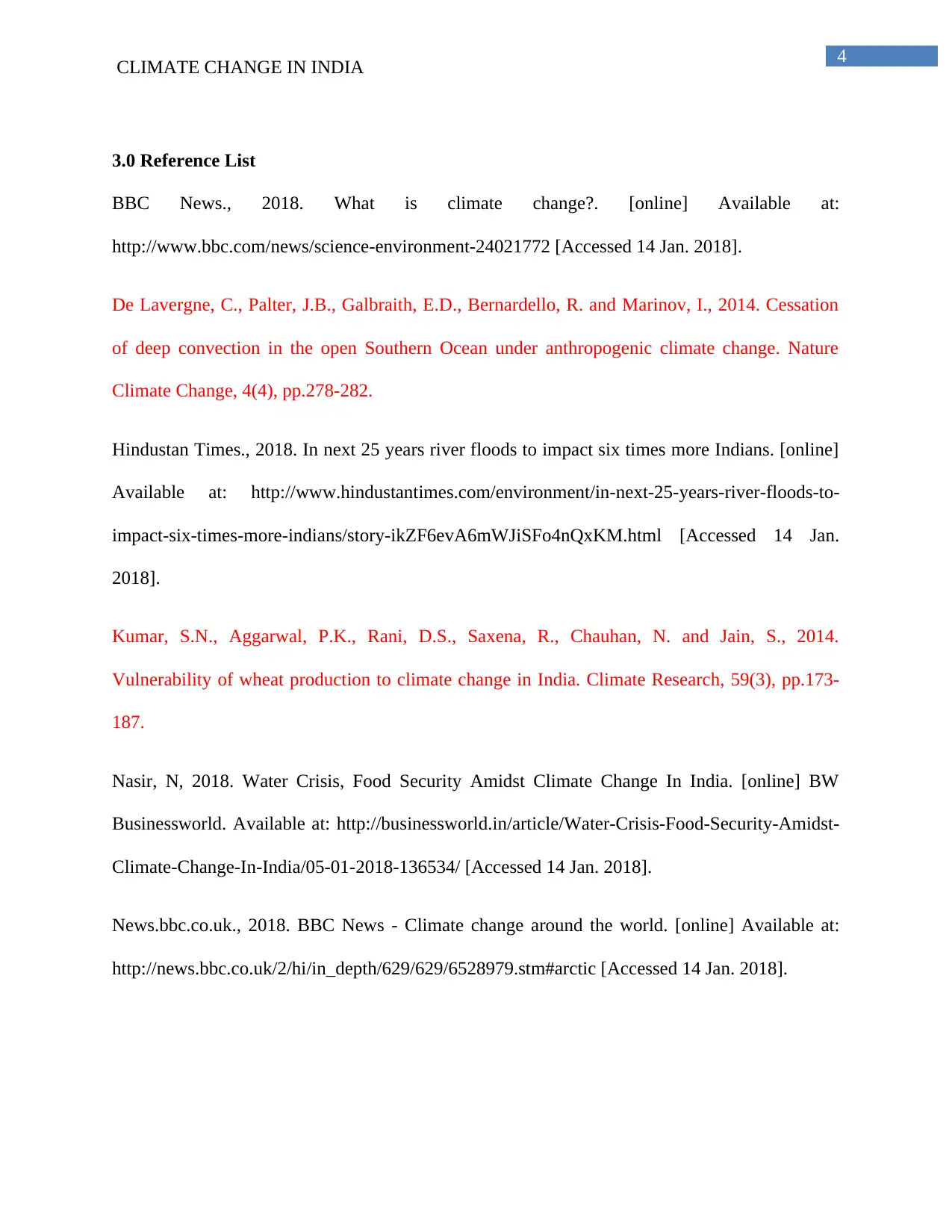
4
CLIMATE CHANGE IN INDIA
3.0 Reference List
BBC News., 2018. What is climate change?. [online] Available at:
http://www.bbc.com/news/science-environment-24021772 [Accessed 14 Jan. 2018].
De Lavergne, C., Palter, J.B., Galbraith, E.D., Bernardello, R. and Marinov, I., 2014. Cessation
of deep convection in the open Southern Ocean under anthropogenic climate change. Nature
Climate Change, 4(4), pp.278-282.
Hindustan Times., 2018. In next 25 years river floods to impact six times more Indians. [online]
Available at: http://www.hindustantimes.com/environment/in-next-25-years-river-floods-to-
impact-six-times-more-indians/story-ikZF6evA6mWJiSFo4nQxKM.html [Accessed 14 Jan.
2018].
Kumar, S.N., Aggarwal, P.K., Rani, D.S., Saxena, R., Chauhan, N. and Jain, S., 2014.
Vulnerability of wheat production to climate change in India. Climate Research, 59(3), pp.173-
187.
Nasir, N, 2018. Water Crisis, Food Security Amidst Climate Change In India. [online] BW
Businessworld. Available at: http://businessworld.in/article/Water-Crisis-Food-Security-Amidst-
Climate-Change-In-India/05-01-2018-136534/ [Accessed 14 Jan. 2018].
News.bbc.co.uk., 2018. BBC News - Climate change around the world. [online] Available at:
http://news.bbc.co.uk/2/hi/in_depth/629/629/6528979.stm#arctic [Accessed 14 Jan. 2018].
CLIMATE CHANGE IN INDIA
3.0 Reference List
BBC News., 2018. What is climate change?. [online] Available at:
http://www.bbc.com/news/science-environment-24021772 [Accessed 14 Jan. 2018].
De Lavergne, C., Palter, J.B., Galbraith, E.D., Bernardello, R. and Marinov, I., 2014. Cessation
of deep convection in the open Southern Ocean under anthropogenic climate change. Nature
Climate Change, 4(4), pp.278-282.
Hindustan Times., 2018. In next 25 years river floods to impact six times more Indians. [online]
Available at: http://www.hindustantimes.com/environment/in-next-25-years-river-floods-to-
impact-six-times-more-indians/story-ikZF6evA6mWJiSFo4nQxKM.html [Accessed 14 Jan.
2018].
Kumar, S.N., Aggarwal, P.K., Rani, D.S., Saxena, R., Chauhan, N. and Jain, S., 2014.
Vulnerability of wheat production to climate change in India. Climate Research, 59(3), pp.173-
187.
Nasir, N, 2018. Water Crisis, Food Security Amidst Climate Change In India. [online] BW
Businessworld. Available at: http://businessworld.in/article/Water-Crisis-Food-Security-Amidst-
Climate-Change-In-India/05-01-2018-136534/ [Accessed 14 Jan. 2018].
News.bbc.co.uk., 2018. BBC News - Climate change around the world. [online] Available at:
http://news.bbc.co.uk/2/hi/in_depth/629/629/6528979.stm#arctic [Accessed 14 Jan. 2018].
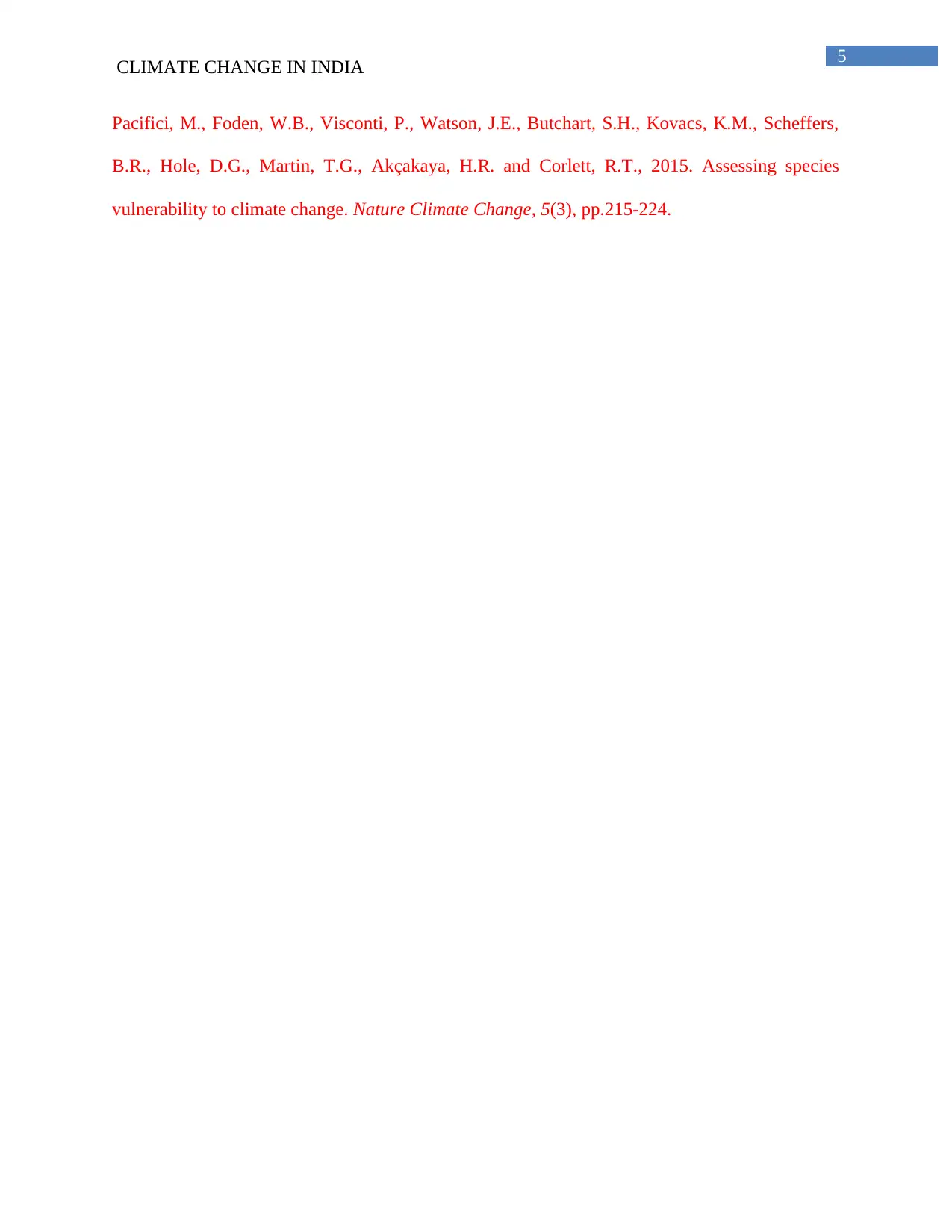
5
CLIMATE CHANGE IN INDIA
Pacifici, M., Foden, W.B., Visconti, P., Watson, J.E., Butchart, S.H., Kovacs, K.M., Scheffers,
B.R., Hole, D.G., Martin, T.G., Akçakaya, H.R. and Corlett, R.T., 2015. Assessing species
vulnerability to climate change. Nature Climate Change, 5(3), pp.215-224.
CLIMATE CHANGE IN INDIA
Pacifici, M., Foden, W.B., Visconti, P., Watson, J.E., Butchart, S.H., Kovacs, K.M., Scheffers,
B.R., Hole, D.G., Martin, T.G., Akçakaya, H.R. and Corlett, R.T., 2015. Assessing species
vulnerability to climate change. Nature Climate Change, 5(3), pp.215-224.
⊘ This is a preview!⊘
Do you want full access?
Subscribe today to unlock all pages.

Trusted by 1+ million students worldwide
1 out of 6
Related Documents
Your All-in-One AI-Powered Toolkit for Academic Success.
+13062052269
info@desklib.com
Available 24*7 on WhatsApp / Email
![[object Object]](/_next/static/media/star-bottom.7253800d.svg)
Unlock your academic potential
Copyright © 2020–2025 A2Z Services. All Rights Reserved. Developed and managed by ZUCOL.





